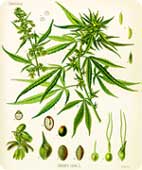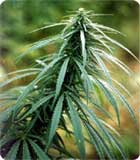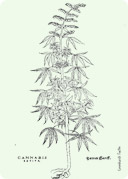Cannabis sativa (hemp) as Medicine
Introduction

With the establishment of modern pharmacology, the therapeutic potencies of hemp have moved into the background while its abuse as a drug has been emphasised. At present, there are attempts to differentiate between the intoxicating and medicinal effects clearly and soberly and to examine whether the therapeutic effects described in a large number of individual observations can be verified by clinical studies under controlled conditions.
As a drug, cannabis is used in the form of various products with names like marijuana (cannabis weed), hashish (cannabis resin), charas, bhang, ganja and sinsemilla. The most important medically active, but also the psychotropic (intoxicating) substance is Delta-9-Tetrahydrocannabinol (THC).
The doses to be prescribed are between 5 mg and 20 mg THC a day. This is mostly tolerated without side effects or in individual cases with light side effects (e.g. dry mouth, dizziness and palpitations). Since cannabis has a comparably limited addictiveness, within the framework of medical treatment no development of dependence is expected.
Cannabis as a narcotic

The Federal Ministry of Health announced a reclassification of cannabis extract as a presciption drug for 2004 but later decided against it. Thus, the contradictory situation persists that the main component (THC), wich is almost exclusively responsible for the addictive qualities of the plant, is legally available as a prescription drug whereas preparations from the whole plant (Cannabis) are not.
Cannabis as a whole is more than the sum of its parts
Modern cannabis research began with the isolation and partial synthesis of the most important ingredient Delta-9-THC (1964) and reached a highpoint in 1988 with the discovery of specific cannabis receptors in the brain and later also on immune cells and in the representation of endogenic ligands, i.e. the body’s own cannabinoids, called anandamides (1992).Delta-9-THC is the cannabinoid most extensive and thoroughly studied. Other important main cannabinoids are cannabidiol (CBD), cannabinol (CBN), cannabigerol (CBG) and Delta-8-THC. Cannabidiol (CBD), which is the second most important substance in cannabis, has anti-spastic and anti-convulsive effects like THC and reduces pain. However, it is particularly important that CBD dampens the psychotropic effects and thus can counter the frequent and most unpleasant side-effects of isolated THC. Other positive effects of CBD in respect of alleviating THC effects are the dampening of tachycardia trigged by THC, normalisation of the slowed time perception caused by THC and a weakening of the THC-induced dazed state.
It is therefore likely that a cannabis extract containing both THC and CBD as main components is more balanced and tolerable than isolated or synthesised THC, the clinical use of which is often limited by the psychotropic side-effects.

Other indications
In future, the following medical applications could be realised for Cannabis:- Pain: Animal experiments have shown that THC and other cannabinoids can strengthen the analgesic effects of opiates. A placebo-controlled single-case study showed a clear reduction in the morphine requirement when prescribing a standardised cannabis extract in the case of severe pain due to inflammatory reactions in a Malta fever patient. There are also a number of results from animal experiments indicating that cannabinoids could be especially helpful against neuropathic pain.
- Migraines: A range of individual case reports prove the good effectiveness of cannabis against this illness, which is difficult to influence by currently licensed products. Possible mechanisms for this effect have been studied.
- Spasms and movement disorders: The relaxing and pain-reducing effect of cannabis is particularly pronounced against spasms resulting from multiple sclerosis or damage to the spinal cord and also against menstrual pain. In an epidemiological survey, more than 90% of 112 MS patients questioned said that smoking cannabis was able to improve spasms, tremors and pain effectively.
- Glaucoma: Back in 1971, it was documented that smoking cannabis reduced internal eye pressure by around 50%. This effect was also achieved with oral and intravenous Delta-9-THC and Delta-8-THC. It was later shown that Delta-9-THC and cannabigerol (CBG) increased the aqueous humour flow by two to three times.
- Asthma: Inhaled cannabis expands the bronchia. In order to avoid the damage caused to the mucus membrane by smoking, aerosols are being developed. Already in the 1970s, it was shown that Delta-9-THC inhaled as an aerosol caused comparable improvements in the functioning of the lungs as beta sympathomimetics.
- Other possible indications: disturbed sleep, reactive depressive conditions, epilepsy and movement disorders caused by medication for Parkinson’s disease.
